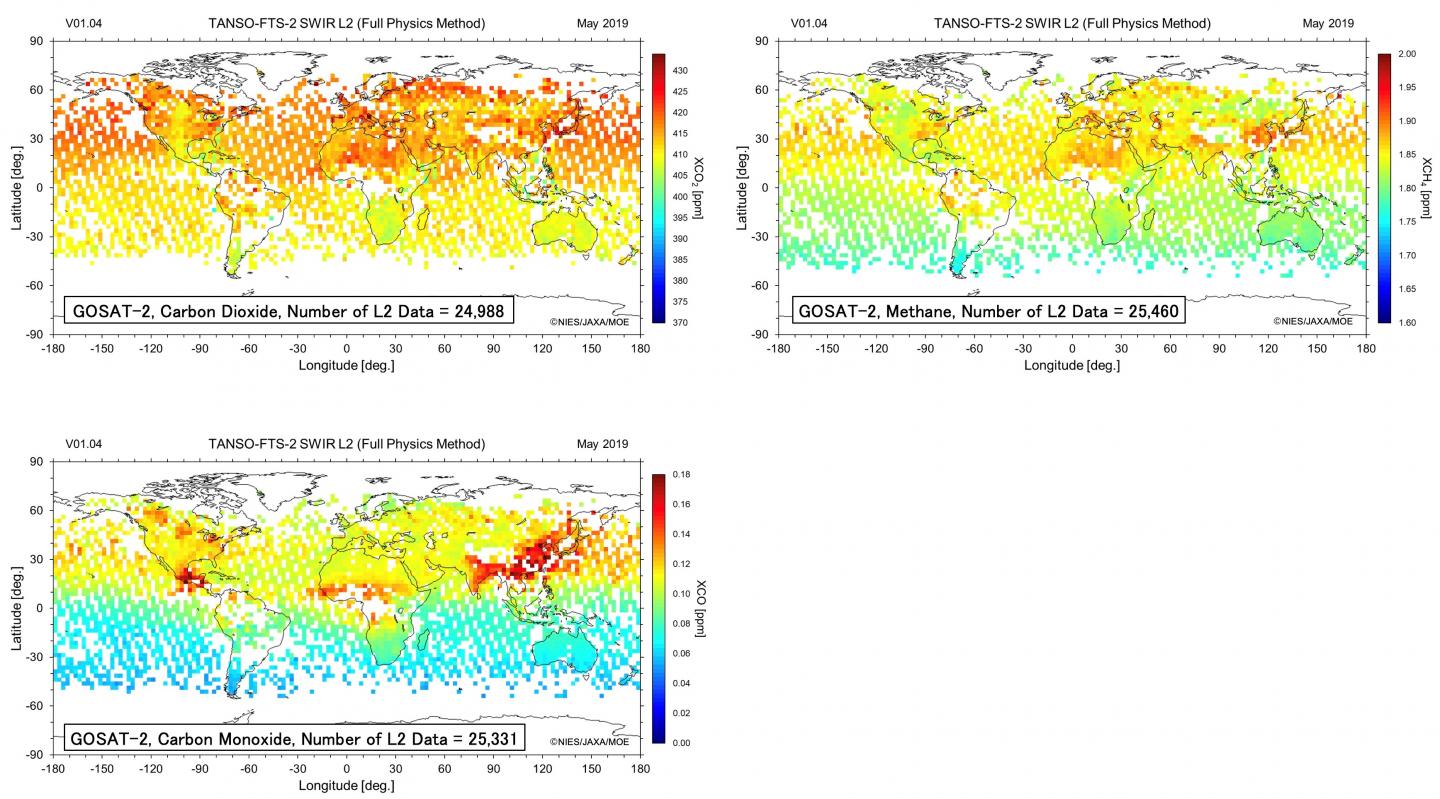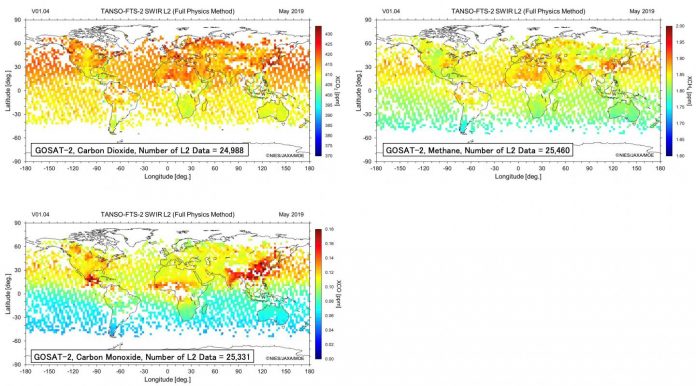
Photo: Global distributions of XCO2 (upper left), XCH4 (upper right) and XCO (lower left) retrieved from GOSAT-2 FTS-2 data in May 2019 using the full physics method (in 2.5-degree mesh)….
view more
Credit Image: NIES/JAXA/MOE
Greenhouse gasses Observing SATellite-2 “IBUKI-2” (GOSAT-2) is a joint project promoted by the Ministry of the Environment of Japan (MOE), the Japan Aerospace Exploration Agency (JAXA) and the National Institute for Environmental Studies (NIES) (hereinafter, collectively, the “Three Parties”) as the successor to Greenhouse gasses Observing SATellite “IBUKI” (GOSAT), which was launched in 2009 and is still in operation.
GOSAT-2 was launched on October 29, 2018 from the JAXA Tanegashima Space Center with the H-IIA Launch Vehicle No. 40 (H-IIA F40). Later, GOSAT-2 collected the first light data with the onboard instruments: first on November 5-6, 2018, images with the Thermal And Near infrared Sensor for carbon Observation – Cloud and Aerosol Imager-2 (CAI-2), and on December 12-14, 2018, data with the Thermal And Near infrared Sensor for carbon Observation – Fourier Transform Spectrometer-2 (FTS-2), confirming that the onboard instruments were operating normally. Further, on February 1, 2019, GOSAT-2 shifted its operation mode to nominal and started global observations by CAI-2 and FTS-2. Note that the spectral radiance data observed by CAI-2 and FTS-2 have been distributed to the public as GOSAT-2 Level 1B Product from the following website since August 5, 2019:
GOSAT-2 Product Archive, National Institute for Environmental Studies
Subsequently, on July 5, 2019, NIES released the first retrieval results of methane (CH4) and carbon monoxide (CO) by a proxy-method (see http://www.
This press release provides an overview of the retrieval results of carbon dioxide (CO2), CH4 and CO by a full physics method. As for CO2 retrieval results, this is the first report from the GOSAT-2 observation. The full physics method is designed to calculate light propagation in the atmosphere based on a physical model, and used for GOSAT-2 to simultaneously retrieve column-averaged dry-air mole fractions of CO2, CH4 and CO. Among the greenhouse-gas-monitoring satellites currently in operation, GOSAT-2 is the only satellite capable of simultaneously estimating column-averaged concentrations of these three gas species.
Figure 1 shows the global distributions of column-averaged dry-air mole fractions of CO2, CH4 and CO (denoted by XCO2, XCH4 and XCO, respectively) retrieved from GOSAT-2 FTS-2 data in May 2019 using the full physics method.
As seen from the whole-atmosphere monthly mean CO2 concentration based on GOSAT observation in May 2019 that hits the record high of 409.4 ppm at that time (see http://www.
Figure 2 shows the global distributions of column-averaged dry-air mole fractions of CO2 and CH4 retrieved from GOSAT FTS data in May 2019 using the full physics method. As seen from the figures, the areas, where GOSAT-2 data are available, have increased significantly compared to the areas with GOSAT data, including oceans and tropical regions with frequent cloud cover. The number of observed data from which CO2 and other gas species are successfully retrieved is 11,000 for GOSAT and 25,000 for GOSAT-2, which is 2.3 times the number of GOSAT. This increase owes mainly to the two technical improvements: the intelligent pointing mechanism–a new function introduced to FTS-2 that discriminates cloudy areas in real time using the camera installed inside the FTS-2 and automatically changes the observation point to a cloud-free area; and the extended range of possible pointing angle in the flight (along-track) direction in relation to sun glint observations over the ocean.
The retrieval results of CO2 and other gases based on GOSAT-2 FTS-2 data using the full physics method have been validated with the ground-based observation data of the Total Carbon Column Observing Network (TCCON). By comparing FTS-2 data (land area) from March to May 2019 with ground-based data collected at 23 TCCON sites (Figure 3), a difference between these two data was found to be 4.1 ± 3.8 ppm (1.0 ± 0.9%) for CO2, 5.5 ± 17.4 ppb (0.3 ± 0.9%) for CH4, and 21.2 ± 9.0 ppb (22.7 ± 9.7%) for CO. (All these data from GOSAT-2 are higher than the TCCON data.) Although these values are better than GOSAT data two years after its launch, they have not reached the quality level of the latest data products from GOSAT FTS (V2.90, -0.35 ± 2.19 ppm (-0.1 ± 0.6%) for CO2, 2.2 ± 13.4 ppb (0.1 ± 0.7%) for CH4). Further improvement in the data products from GOSAT-2 is needed.
This result by the full physics method reported in this press release has been provided together with the result by the proxy method as GOSAT-2 Level 2 Product, to researchers whose research proposals have been adopted on the GOSAT Series Research Announcements (1st and 2nd RAs) and research organizations that have signed collaboration agreements with MOE, JAXA, and/or NIES. Once the related documents including validation results are ready, all these data products will be newly released to the general public from GOSAT-2 Product Archive.
We will work on further improvement in retrieval accuracy and increase in the number of retrieved data. Furthermore, we plan to proceed with inversion analysis of net fluxes, generation of Level 4 products, and estimation of anthropogenic emissions, and succeed to GOSAT’s results in a progressive manner.
###
TDnews (tunisiesoir.com)















